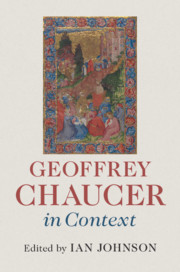Book contents
- Geoffrey Chaucer in Context
- Geoffrey Chaucer in Context
- Copyright page
- Contents
- Illustrations
- Contributors
- Abbreviations
- Introduction
- Part I Chaucer as Context
- Part II Books, Discourse and Traditions
- Part III Humans, the World and Beyond
- Part IV Culture, Learning and Disciplines
- Part V Political and Social Contexts
- Chapter 34 Dissent and Orthodoxy
- Chapter 35 The Church, Religion and Culture
- Chapter 36 England at Home and Abroad
- Chapter 37 Chaucer’s Borders
- Chapter 38 Rank and Social Orders
- Chapter 39 Chivalry
- Chapter 40 Chaucer and the Polity
- Chapter 41 The Economy
- Chapter 42 Towns, Villages and the Land
- Chapter 43 London’s Chaucer
- Chapter 44 Everyday Life
- Chapter 45 Household and Home
- Chapter 46 Marriage
- Chapter 47 Dress
- Part VI Chaucer Traditions
- Further Reading
- Index
Chapter 38 - Rank and Social Orders
from Part V - Political and Social Contexts
Published online by Cambridge University Press: 24 June 2019
- Geoffrey Chaucer in Context
- Geoffrey Chaucer in Context
- Copyright page
- Contents
- Illustrations
- Contributors
- Abbreviations
- Introduction
- Part I Chaucer as Context
- Part II Books, Discourse and Traditions
- Part III Humans, the World and Beyond
- Part IV Culture, Learning and Disciplines
- Part V Political and Social Contexts
- Chapter 34 Dissent and Orthodoxy
- Chapter 35 The Church, Religion and Culture
- Chapter 36 England at Home and Abroad
- Chapter 37 Chaucer’s Borders
- Chapter 38 Rank and Social Orders
- Chapter 39 Chivalry
- Chapter 40 Chaucer and the Polity
- Chapter 41 The Economy
- Chapter 42 Towns, Villages and the Land
- Chapter 43 London’s Chaucer
- Chapter 44 Everyday Life
- Chapter 45 Household and Home
- Chapter 46 Marriage
- Chapter 47 Dress
- Part VI Chaucer Traditions
- Further Reading
- Index
Summary
The population of England declined by around fifty percent during Chaucer’s lifetime, mainly as a result of plague. Apart from much grief, this also created dislocation, opportunity, growing social mobility and rising expectations, which were vigorously resisted by the rich and powerful. Social awareness increased, and with it social stratification, not only among the aristocracy, with the emergence of new ranks such as marquis and viscount and a closely defined peerage, but also among the middling and poorer ranks of society. Terms such as ‘gentleman’ and ‘yeoman’ became common as social signifiers of those who were inferior to the knights and esquires who made up the gentry, but superior to the mass of the peasantry. Such demarcation lines were never absolute, but they were not crossed unobtrusively. This social awareness is reflected in the Canterbury Tales. Some of the individual pen-portraits of the pilgrims in the General Prologue appear to present aspirations rather than reality, yet behind this lies an unmistakable echo of the social fluidity of the age, a topped-and-tailed cross-section of a society in transition.
- Type
- Chapter
- Information
- Geoffrey Chaucer in Context , pp. 324 - 330Publisher: Cambridge University PressPrint publication year: 2019

